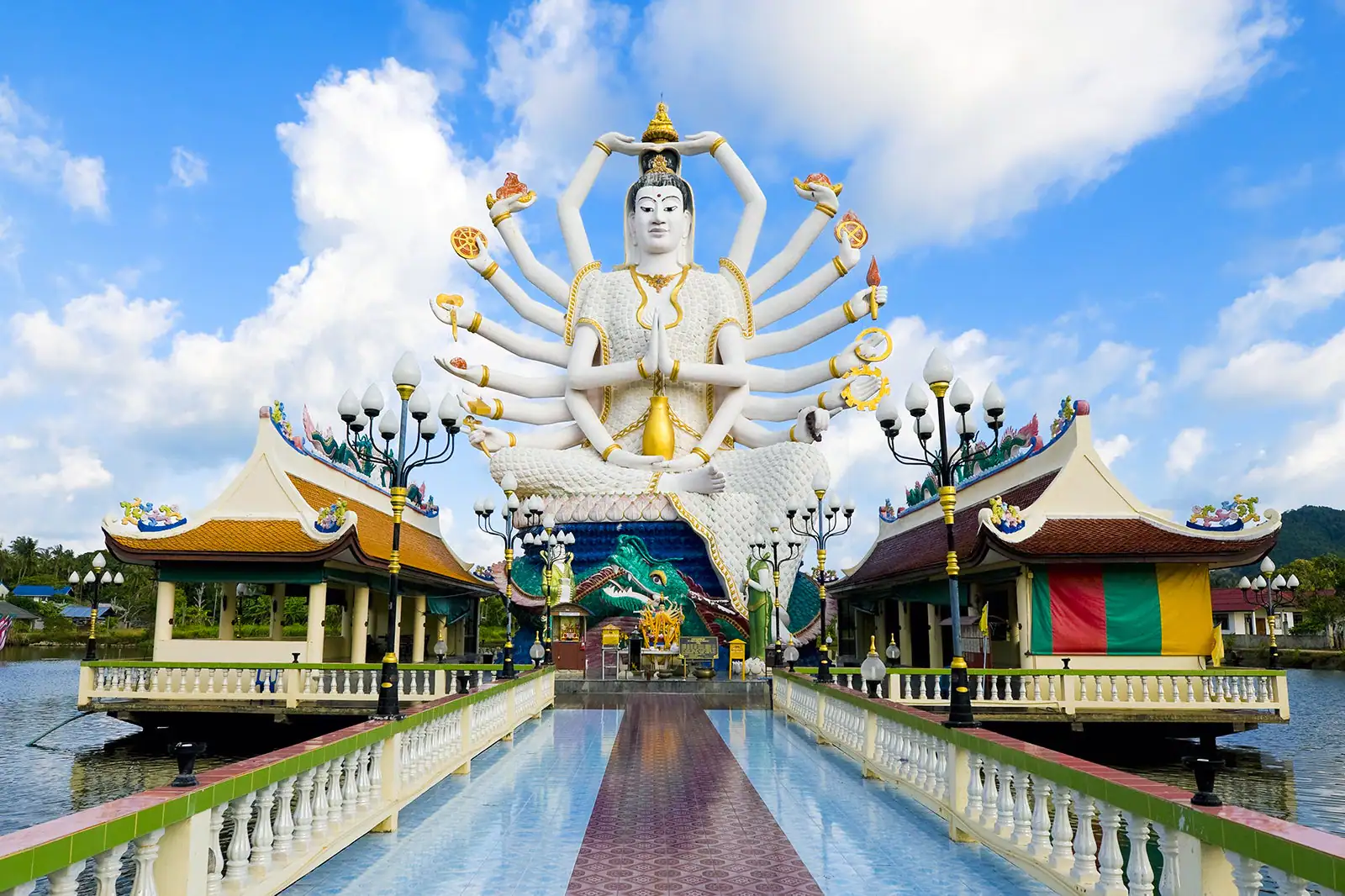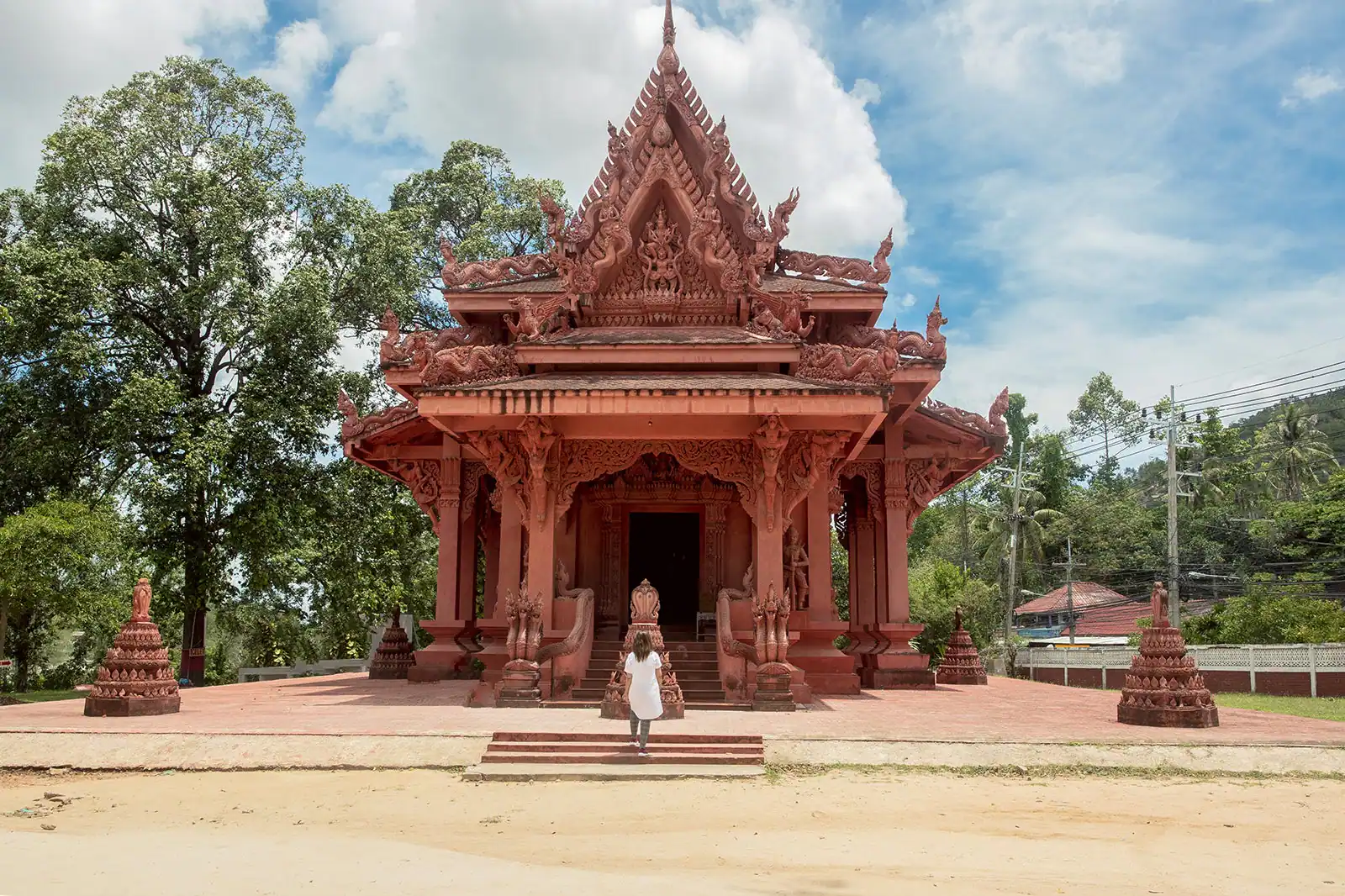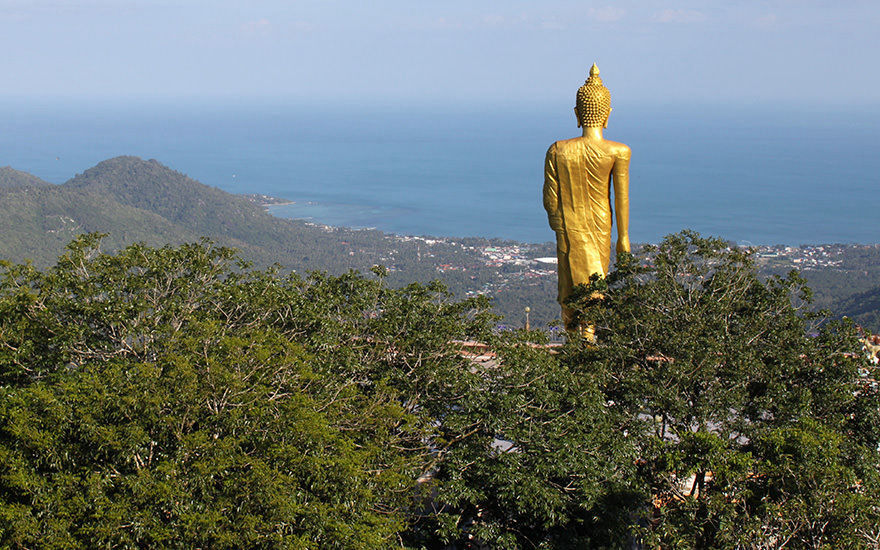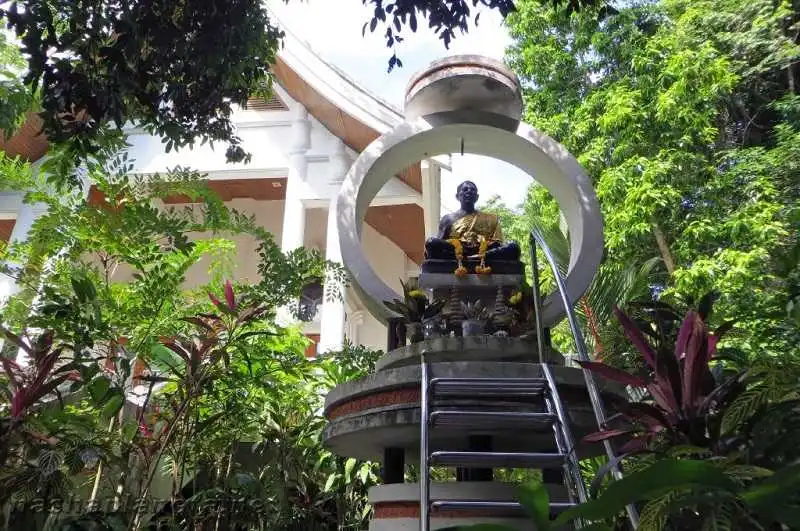

Big Buddha - Wat Phra Yai
The Big Buddha on the northern coast of Koh Samui is one of Thailand's famous shrines and probably Samui's best-known landmark. The 12-metre-tall golden Buddha statue can be seen from several kilometres away. The Buddha figure sits in the Mara posture, depicting a time during Buddha's journey to enlightenment where he successfully subdued temptations and dangers thrust at him. The pose is a symbol of steadfastness, purity and enlightenment.
At the base of the Big Buddha statue there are 2 more Buddha images set in pavilions. A staircase with a colourful dragon design leads up to the platform area on which the Buddha sits. Inside the surrounding temple are many different shrines and other smaller Buddhas. There's also a small market selling a wide range of lucky charms and other souvenirs, alongside numerous food stalls.

Buddhist devotees come daily to make offerings of fruit and flowers and light incense at the base of the statue. Curious tourists are welcome to come and observe these graceful religious rituals any time of the day. All over Thailand, the wat (temple) serves as a major centre for cultural festivals. The Big Buddha Temple in Koh Samui is no exception. During festivals like Loy Kratong or Songkran, the temple becomes crowded with people making merit and enjoying entertainment, food, and markets set up in celebration.

Besides offering an insight into the local culture, the platform affords excellent beach and sea views. By night, the Big Buddha is bathed in the golden glow of spotlights. The temple is open all day, but for those hoping to catch a true cultural experience, it’s best to go in the early morning. You can see locals bringing offerings to the temple and monks do their morning chants. A visit to Big Buddha is usullay always included in most Island safaris and City tours.

Wat Plai Laem
Wat Plai Laem is a Buddhist temple compound on Samui's northeast coast, which features a striking white, 18-armed image of Guanyin, the Goddess of Mercy and Compassion. Close to the Big Buddha temple, Wat Plai Laem offers visitors a view into Chinese-Thai beliefs as well as some elaborate Buddhist art and architecture.
Wat Plai Laem is a living and active temple. It's where devotees come daily to pay homage to Guanyin and the Buddha, who is also depicted in a number of statues and murals around the temple. The art techniques used in its creation are centuries old and based on ancient beliefs. Adding to its feel of tranquillity, the temple is surrounded by a lake, which is teeming with fish. Visitors who make a donation to the temple are given a bag of food to feed the fish.

The giant Guanyin statue is a towering white structure in the centre of the temple grounds. It forms an imposing and serene presence and a showcase of Koh Samui's strong Chinese heritage. The temple's intricate designs were created by one of Thailand's foremost artists, Jarit Phumdonming. The Goddess is flanked by 2 long halls that feature colourful murals and frescoes depicting Buddhist myths and stories.
Guanyin is believed to be a source of unconditional love and a protector of all beings. Her multitude of arms is seen as an illustration of her ability to reach out and provide help across the world. She is also seen as a fertility goddess and many who come here pray for her help in bearing healthy children. As well, Guanyin is believed by some to help protect sailors at sea.

Other standout features at Wat Plai Laem include a large, white laughing Buddha statue, beautifully carved teak entry doors, and an elaborate ubosot (ceremonial hall) set on an island in the lake. Wat Plai Laem is open to visitors all day during daylight hours and is particularly lively during Chinese festivals such as the Lunar New Year.

Wat Ratchathammaram
Wat Ratchathammaram is a Buddhist temple along the Samui Ring Road. It also goes by the name Wat Sila Ngu, which means 'stone snake' in English. You can see many stone-carved snakes all around the compound. This long-established temple has a magnificent building in deep red clay, which adds to the mysterious yet serene atmosphere of the temple. The large room it houses is pretty sombre, with its walls entirely carved with scenes of Buddha's life. Wat Ratchathammaram's seaside location affords splendid views of Koh Samui's east coast.

The Guan Yu Shrine
The Guan Yu Shrine, on the main road in the south of Koh Samui between Lamai and Hua Thanon, is a 16-meter bronze war statue that was built by a Chinese islander to celebrate Chinese heritage in 2016. It is a really impressive temple complex, with small souvenir stands and restaurants in the entrance area.

Wat Phra Chedi Laem Sor
Wat Phra Chedi Laem Sor occupies an oceanfront setting in Na Mueang. The temple sits astern, surrounded by a pool of water, making it look like it's in the Andaman Sea. This temple is especially impressive when seen from Pagoda Khao Chedi, located on a hill above Bang Kao Beach. What you'll see is a large, bright-blue vessel shaded by coconut trees.

Secret Buddha Garden
The Secret Buddha Garden lies at the summit of Pom Mountain, one of the highest peaks of Koh Samui. The sculpture park offers majestic views and an unusual collection of statues amid lush jungle surroundings.
The site, also known as Namtok Tar Nim or Magic Garden, was the work of an old Samui fruit farmer, Nim Thongsuk. In 1976, he began erecting several Buddhism-inspired and Apsara statues around his family's verdant land. Today, this garden is a great place to unwind, thanks to its mystical atmosphere.

Wat Khunaram
Wat Khunaram, home to Koh Samui’s mummified monk, is an unusual sight yet it offers a unique insight into Buddhist and Thai culture. The monk, Luong Pordaeng, died in 1973 in a seated meditative position, and ever since his body has been on display in an upright glass case at the temple. Remarkably, even after several decades, the monk’s body shows little sign of decay. For some visitors, having a dead man in full view might be a shocking sight. But for Thais, it’s something to reflect upon and revere.
Far from being frightened by death, most Buddhist Thais are highly accepting of the end of life as the natural order of things and they view death as an opportunity to be reborn into a better place, one step closer to nirvana. There are other mummy monks on Samui and throughout Thailand, but Loung Pordang is among the most highly revered.

Loung Pordang is said to have told his followers shortly before his death that if his body were to decompose, he should be cremated. Otherwise, he wanted to be put on display as a visual reminder of the Buddha’s teachings. For Thais, both the life and death of Loung Pordang serve as an inspiration to follow the Buddhist precepts and walk the middle path.
Aside from the Mummy Monk, Wat Khunaram is a fairly typical Buddhist temple, where local people come daily to make merit and pray. Amulets and other Buddhist artefacts may be bought, and visitors are welcome to join or observe the daily rituals and have a look around. A visit to Wat Khunaram and the 'mummified monk' is usullay always included in most guided Island safari and city tours.

Wat Teepangkorn
Wat Teepangkorn is located at the highest viewpoint on the island- 605m. A large golden Buddha 'Pra Buddha Dipankara' stands at the center of the sight. From here there is a panoramic 360-degree view of the island overlooking Lamai beach and the coconut groves below. This sight can only be reached with a 4WD off-road vehicle and an experienced driver, it's not reccommended to attempt the ascent by yourself. A visit to the Wat Teepangkorn 'Pra Buddha Dipankara' vantage point is often included on most island jungle safari tours.

Wat Lamai
Wat Lamai is the social epicentre for the local Thai community in Koh Samui. It hosts lively temple fairs throughout the year, with concerts, fairground games, food and even an outdoor cinema. The temple fairs last for over a week, so it's a good idea to check one out when you're in Lamai.
Inside the temple complex, you'll find a cultural hall that houses a collection of quaint artefacts from Samui's past. You can see brass and earthenware vessels, cooking implements, wooden agricultural tools, swords, ancient bicycles, and a 2,000-year-old metal ceremonial drum.

Wat Chaeng
Wat Chaeng is a superbly designed temple with an adjoining school. Located in Nathon, the temple building has a large sculpture of Buddha in the pang prathanporn pose, with 1 hand raised with the index finger and thumb touching and the other hand (palm facing up) on his lap.
The temple and Buddha image are guarded by 2 huge statues in green and gold. To get to Wat Chaeng, head to the southern end of Thaweerat Phakdee Road (4169 through Nathon) and left into the temple grounds.
> Open in Google Maps

Laem Sor Pagoda
Laem Sor Pagoda is a cultural landmark at the southernmost tip of Koh Samui, which is also the end of Bang Kao Beach. Its golden hue, glowing in the sunlight, makes for an astonishingly beautiful contrast to the blue sky and the turquoise sea behind it.
The entrance is guarded by 2 yak (“giants” in Thai) warrior statues with immense swords, colorful clothing and scary faces. Buddha stands in the doorway to the rear of the statues. This one is always a great photo opportunity as there is absolutely nothing obstructing your view and it all fits on one photograph. It's about 11 km south of Lamai.

Buddha's Footprint
Buddha's Footprint in Koh Samui can be a bit challenging to spot, but it's well worth putting in the extra effort to get there. It's on a hilltop shrine near the Butterfly Garden at Laem Natien, around 2.5 km north of Bang Kao Beach. Buddha's Footprint consists of 4 footprints engraved on top of each other. After tackling 163 steps to the top, you'll be rewarded with one of the most spectacular views on the island.

Pagoda Khao Hua Jook
Pagoda Khao Hua Jook is on a 90-metre-high hill in Bophut, overlooking the landing strip of Samui International Airport. If you like watching flight takeoffs and landings, this is the place to sit for a while. Inside, the Temple contains a replica of Buddha's footprint. However most people come here for the panaromic vistas, as Koh Phangan, Koh Tao, Koh Sum, Koh Lum Noi, Koh Tao and Big Buddha Temple are visible from this spot.

Hin Lad Waterfall Temple
Hin Lad Waterfall Temple (Wat Namtok Hin Lad) is a Buddhist shrine within an evergreen tropical jungle, just before a trail leading up to the famous Hin Lad Waterfall. It's around 3.1 km southeast of Nathon Town in Koh Samui. A stroll around Hin Lad Waterfall Temple can be very enjoyable with plenty of photo opportunities

Hin Lad Waterfall Temple is usually busy on weekends – locals visit the temple to make merit and enjoy a picnic at the nearby waterfall. The temple is well shaded and calm, making it an excellent place to unwind and relax. It has a lovely garden, walking path, various Buddha images, religious sculptures and a meditation area.

Island Tours & Excursions
One of the best ways to see the attractions on Koh Samui and much more, is to book a half-day or full-day island safari or city tour that takes you around Samui, making sure you see the most interesting and unforgettable sights of the island. For trips more further afield, full day trips and sea excursions are also available.
Visitors to Koh Samui can enjoy the benefits of booking tours in advance through our tour partner Viator - Reserve now and pay later with free cancellation up to 24 hours before the tour starts. To browse all tours available on Koh Samui click the insert below: